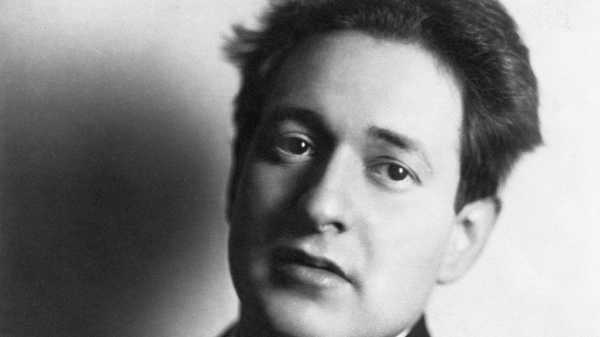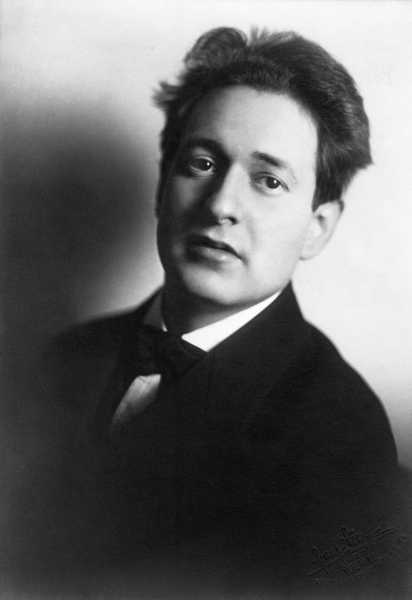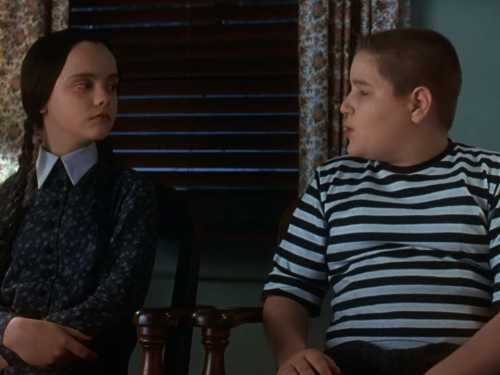

Arguably, the movies saved Korngold’s life, but his film activity eroded his reputation in so-called serious circles.Photograph from Bettmann / Getty
In high school, I spent long hours in the art room, painting in a pseudo-Turneresque manner and listening to music. A former teacher had installed a record-player and assembled a collection of classical albums, favoring the stormy twilight of symphonic Romanticism. Late in the day, after everyone had gone, I could turn up the volume to wake-the-dead levels. I became fixated on John Barbirolli’s recording of the Mahler Sixth, with its zombie tread in the first movement and its helter-skelter intensity in the finale. The last movement sprawled across two LP sides, and the break between them fell at a bad moment, in the middle of a harmonic progression. Whenever I hear the Sixth, I flinch as that passage approaches.
A more unexpected discovery was Erich Wolfgang Korngold’s Symphony in F-Sharp—the musical testament of a supernaturally gifted Austrian Jewish composer who took refuge in Hollywood after the Anschluss. I had seen “The Adventures of Robin Hood” and associated Korngold with Errol Flynn running up and down staircases. The symphony, though, seemed far removed from movie fantasy. It was a rigorous, disciplined four-movement narrative, squarely in the Beethoven-to-Bruckner line, proceeding from coiled struggle to spacious triumph. The third movement, the Adagio, rose to an agony of sorrow that felt private rather than performative; dissonances shuddered and splintered in the air. I listened to Mahler and Korngold interchangeably, not knowing that you were supposed to hail one as a master while spurning the other as a purveyor of anachronistic Romantic kitsch.
Almost forty years later, I finally got to experience the Symphony in F-Sharp live, when Kirill Petrenko and the Berlin Philharmonic gave a magnificent rendition of the piece at Carnegie Hall in November. This was deluxe treatment for a composer who had long worn an asterisk on account of his Hollywood fame. Arguably, the movies saved Korngold’s life: when the Nazis took over Austria, he was on the Warner Bros. lot, scoring “Robin Hood.” At the same time, his film activity eroded his reputation in so-called serious circles. For seven decades, from 1932 to 2002, the Berlin Philharmonic didn’t touch his music, and the orchestra’s performances of the symphony this fall were its first. The work’s clamorous reception at Carnegie was a kind of restitution.
I recently visited the Erich Wolfgang Korngold Collection in the Music Division of the Library of Congress, looking for clues to the grand enigma that is the Symphony in F-Sharp. The autograph score is a massive object, consuming two hundred and two pages of broadsheet-sized paper. On the title page is written, in block red letters, “DEDICATED TO THE MEMORY OF FRANKLIN DELANO ROOSEVELT.” Like most German-speaking émigrés, the composer revered Roosevelt as an enlightened savior. Korngold toiled at the project from 1947 to 1952 and knew the worth of what he had achieved. With its strict formal plan and rugged harmonic language, the symphony was self-evidently designed to mark his reëmergence as a concert composer after the interregnum of war and Hollywood.
It was not to be. When Korngold sent the manuscript to leading conductors, he was gently rebuffed, as letters in the archive attest. Bruno Walter wrote that, although he admired the work, he could no longer learn a complex new score. Fritz Reiner, after describing the piece as “nobly inspired,” deemed it too lengthy for his programs. Dimitri Mitropoulos declared, “For a long time I was searching for a work that would please me entirely, and believe me, I found it in your Symphony.” Yet he couldn’t find a place for it, either. Perhaps in response, Korngold changed the timings listed on the title page, so that a duration of forty-six minutes dwindled to forty-three. (In fact, most performances last around fifty minutes.) Despite his efforts, the symphony had only a few outings, none of them in America. Korngold died in 1957, at the age of sixty, without having written another major score.
Shostakovich, Prokofiev, Copland, Vaughan Williams, and various other composers had won notice in this period for symphonies charged by current events. Even the arch-purist Stravinsky had hinted at a war program in his Symphony in Three Movements, which premièred in 1946. Korngold, after devoting a full decade to swashbucklers and melodramas at Warner Bros., wished to reaffirm his credentials as an abstract musical thinker, but he was coy about possible messages, as a draft of a program note indicates:
Korngold completed his Symphony in F sharp in 1952. Several ideas as well as themes, especially some for the first two movements, were already conceived in earlier years. The composer characterizes his new symphony as a work of pure, absolute music with no program whatsoever, in spite of his experience, that many people—after the first hearing—read into the first movement the terror and horrors of the years 1933-45 and into the Adagio the sorrows and sufferings of the victims of that time.
Is he discouraging an interpretation of the symphony in light of the war and the Holocaust? Or is he implicitly permitting such a reading, even inviting it?
Indeed, some of the work’s thematic ideas were already in circulation, dating as far back as 1935. What Korngold doesn’t reveal is the context in which they first appeared. As the scholars Robbert van der Lek and Ben Winters have established, Korngold adapted music from at least seven of his Warner Bros. scores. The main theme of the Adagio is derived from “The Private Lives of Elizabeth and Essex,” starring Bette Davis as Queen Elizabeth I and Errol Flynn as her doomed lover, the Earl of Essex. The movement also incorporates fragments of two other Flynn vehicles, “Captain Blood” and “The Sea Hawk,” and a motif from the period drama “Anthony Adverse.” The scherzo draws both on the bio-pic “Juarez” and on the musical thriller “Deception,” in which Korngold invents a compositional persona for the malignant genius played by Claude Rains. The finale makes use of a bounding tune from the Ronald Reagan weepie “Kings Row.” Korngold’s craftsmanship is such that the seams are undetectable.
Are there hidden meanings in the recycling? As Winters notes, the “Captain Blood” material belongs to a series of scenes in which Blood and his comrades, rebels against the British crown, have been sold into servitude and subjected to brutal beatings. Slavery also figures in “Anthony Adverse,” although there the title character is guiltily reaping profit from the trade. The music redeployed in the symphony coincides with a title card that reads, “Sick in mind and body Anthony found no peace from the growing torment within him.” In “Private Lives,” the Adagio theme evokes Essex’s defiance, switching between major and minor modes, and it swamps the soundtrack as the dashing traitor is marched to the scaffold.
Winters detects an autobiographical subtext in these references: Korngold’s employment of slavery motifs in the Adagio “hints at the conflicted relationship he had with his film career,” and his turn to the exuberant “Kings Row” melody in the finale suggests a reconciliation with his Hollywood role. This interpretation seems limiting, particularly since Korngold had considerable latitude at Warner Bros. and was hardly an anonymous cog in the system. Given the composer’s remarks about the “terror and horrors” of war, I’d be more inclined to perceive a memorial impulse in this stringing together of musical images of forced labor, torture, and execution. The dedication to Roosevelt adds a further wrinkle. If the Adagio is a funeral oration, it is a peculiarly anguished and desperate one.
Of course, Korngold may have chosen these passages with no allegorical purpose in mind. Perhaps he was already contemplating a larger-scale musical plan, and film assignments allowed him to try out aspects of it. I used to think that the Symphony in F-Sharp was the anomalous triumph of a composer in decline. Now, having watched all of his movies and studied his manuscripts, I’m convinced that Hollywood actually brought about a further refinement of his style. The symphony is evidence of that, and its neglect is therefore all the more painful.
Petrenko, who has led the Berlin Philharmonic since 2019, is the first Jewish music director in the orchestra’s history. Given that one of his predecessors (Wilhelm Furtwängler) was Hitler’s favorite conductor and another (Herbert von Karajan) joined the Nazi Party not once but twice, Petrenko’s championing of Korngold has a corrective edge. In the same spirit, the conductor has featured Schoenberg, Alexander Zemlinsky, and Kurt Weill, who fled the Nazis, and Ervín Schulhoff, who died in a German internment camp. Preceding the Korngold on the Carnegie program—which the Philharmonic duplicated in visits to Boston and Ann Arbor—was Mozart’s First Violin Concerto, with Noah Bendix-Balgley, one of the orchestra’s concertmasters, as soloist. A descendant of German Jewish émigrés, Bendix-Balgley offered two klezmer tunes as an encore.
Yet Petrenko elected not to dramatize the symphony’s historical background—at least, not on the surface. The performance, like much of this conductor’s work, was tightly controlled, finely detailed, lacking in extravagant gestures. For full-on wildness, you have to go back to the first recording—Rudolf Kempe’s, with the Munich Philharmonic, the one that shook the rafters of my high-school art room. (There have been ten recordings to date; my other favorite is James DePreist’s, with the Oregon Symphony.) At the same time, Kempe’s hectic assault can be wearying over the long haul. Petrenko, by contrast, showed an overriding concern with clarity of texture and continuity of structure. The score contains fiendish difficulties, with whiplash transitions, frequent changes of meter, and unison lines that lunge unpredictably. Instrumental solos are intimate and demanding. The Berliners executed all of it flawlessly, and Petrenko kept the music moving forward without missing its depths. His belief in the piece was obvious.
The three-dimensional richness of the playing emphasized the intricacy of Korngold’s harmonic thinking. We take it for granted that Korngold was a tonally oriented composer who rejected twentieth-century modernism. But his version of tonality can be exceedingly warped. At Carnegie, I was struck anew by his avoidance of unambiguous cadences. As the craggy first movement moves toward a peaceful F-sharp-major close, there is interference from the clarinet, which lands on an A-natural, piercingly at odds with an A-sharp in the trumpets. The clarinet then falls silent, yet the sonority retains a sickly air. The Adagio ends on a weirdly voiced D-minor chord, with oboe and trumpet adding a destabilizing C. Even at the symphony’s jubilant conclusion, the flute throws an extraneous G-sharp into the F-sharp-major frolic.
As for the coda of the Adagio, it becomes the site of a late-Romantic meltdown. Korngold, in his note, gave it the curious label “exstatic ‘Abgesang’ (Aftersong)”; maybe he understood ecstasy in the literal sense of standing outside oneself. The section begins with shimmering tremolos and sensuous arabesques, but the atmosphere rapidly deteriorates, leading to two cataclysmic bars that superimpose F-minor and D-minor progressions in a seven-note howl. Two further attempts at resolving to D minor are marred by colliding tonal plates. Similar effects can be heard in the execution scene of “The Private Lives of Elizabeth and Essex,” but the symphony maximizes the chaos. Rolls on the bass drum threaten to engulf the entire tottering edifice in a cloud of noise.
In Los Angeles, Korngold had convivial relations with his fellow-émigré Arnold Schoenberg, whose revolutionary turn toward atonality seemed diametrically opposed to his own path. The symphony’s expressionistic dissonances show that the two composers were not as far apart as the binary schemes of music history would have us believe. By never cutting himself loose from tonality, Korngold retained an advantage: he could release the expressive power of the system in crisis, again and again. This, possibly, is the ultimate program of the Symphony in F-Sharp, if it has one: tradition facing down its own extinction, and then dancing back to life. ♦
Sourse: newyorker.com






